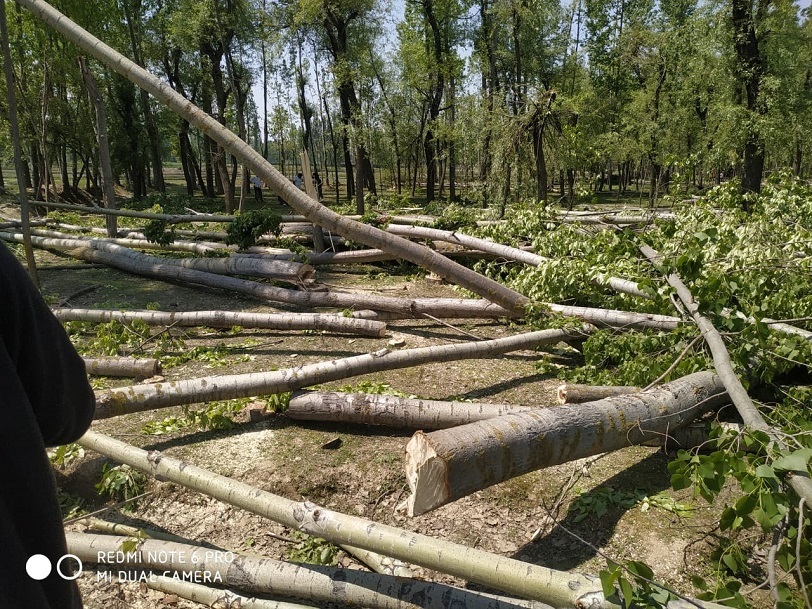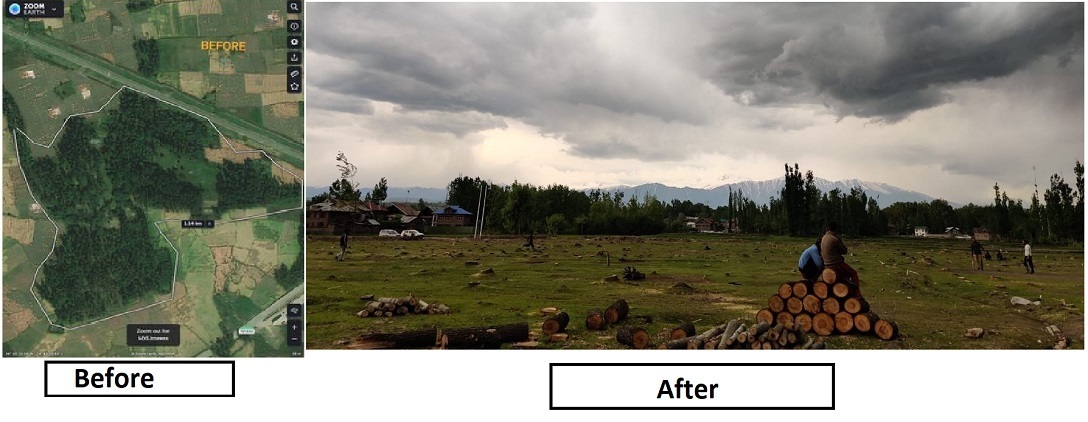
Govt vandalized ecology of area & backtracked from its promise to build a makeshift hospital
THERE is a famous Urdu couplet na khuda hi milaa na visāl-e-sanam na idhar ke hue na udhar ke hue. The literal meaning of this couplet is: I could attain neither God nor union with my beloved. I am neither here nor there, I am left high and dry.
I relate this couplet with the residents of Reshipora village in Budgam district as they were promised a makeshift COVID 19 hospital in the area for which they sacrificed hundreds of green trees in the village in the hope that they would get an alternate benefit. But that didn’t happen at all. The villagers got nothing in return except an environmental catastrophe and ecological devastation.
People of Reshipora had been promised by authorities that a 500 bed makeshift COVID 19 hospital would come up in their village. In fact, the work was also started but within a week or so the work was suddenly stopped and the project was shifted to some other location in Srinagar outskirts. The reason cited by district administration Budgam for shifting the project to Srinagar district is ridiculous. They claim that land in Reshipora was not feasible for hospital construction. Then why did they axe thousands of trees before conducting the necessary soil tests in the area?
Background
The Defence Research and Development Organisation (DRDO) had sponsored the construction of the 500 bedded COVID 19 makeshift hospital in Reshipora for which district administration Budgam had identified 75 kanals (8.5 acres) of village common land. When the residents came to know that land was required for a hospital, they didn’t create any hindrance for the local administration in spite of the fact that their sheep and cattle were directly dependent on this land for fodder. The land was also used as a playground by local youth. The ground clearance work began around May 1st with construction of an approach road over an irrigation canal. This was followed by axing of more than 2500 green trees which included willow, poplar and kicker trees.
The project is a joint initiative between the J&K Government and DRDO. Around May 15th, the Government suddenly decided to shift this hospital project to Khonmoh area in south–east of Srinagar. The Budgam district administration told locals that soil test done in Reshipora was not favourable and thus Govt had decided not to go ahead with this project in the village. This infuriated the residents. After some days the district administration issued a written communication requesting the Government to set up a new district hospital building at Reshipora as the existing district hospital building was too small.
Trees axed before conducting soil tests
The soil testing is primarily done to test the bearing capacity. The chemical and physical composition of the soil is checked during this process. The soil must have the ability to withstand the weight of the building. Quality of soil not only determines the bearing capacity but it ensures the structure stabilization. Quality of soil depends upon various factors such as weather, climate change and for the past years the land was deployed for what purpose and what was there previously. The length and depth of the pillar determined during the foundation depending upon the quality of soil. The water level of the soil only can be determined from soil testing. Based on the soil testing reports quality of material can be decided. For example if due to moisture the area is prone to corrosion then it is important to choose only corrosion resistant TMT bars for the construction. Soil test is a very important step of construction before it begins.

Even if they had plans to construct a multi storey concrete building in the area, the soil testing could have been done even without axing a single tree
In the case of now defunct hospital project at Reshipora Budgam, the DRDO had been planning to construct prefab buildings. Even if they had plans to construct a multi storey concrete building in the area, the soil testing could have been done even without axing a single tree. An estimated 2500 plus trees have been axed in the area, residents told this author during a visit. Some youth counted the number of stumps for several hours and found around 3500 trees have been felled in the area. I was told that around 500 or more trees were axed in the recent past during laying of a high voltage transmission line and around 2500 trees were axed recently to pave a way for construction of the DRDO hospital. I believe the issue related to negative soil tests is not correct at all. Had that been so, the Government could have made the report public. Secondly, the district administration would not have written a letter to the Govt requesting to construct a new district hospital building on the same land.
The construction of the proposed COVID 19 makeshift hospital in Khonmoh area was the government’s afterthought. The Reshipora was made a scapegoat. The district administration in order to calm down the angry residents of Budgam dispatched an official letter addressed to the Financial Commissioner Health and Medical education. The letter No: DDCB/Dist Hospital / 1725-29 Dated: 20.05.2021 signed by Deputy Commissioner Budgam has requested Government to give its green signal for construction of a 300 bedded hospital at Reshipora for which PWD (R&B) had submitted a detailed proposal for Rs 109.57 crore before Directorate of Health, Kashmir.
Monetary value of a tree
A Supreme Court-appointed technical committee has estimated the value of a matured tree at Rs. 74,500 multiplied by its age.
A Supreme Court-appointed technical committee has estimated the value of a matured tree at Rs. 74,500 multiplied by its age. This has generated hope among affected people whose fruit or non-fruit trees are axed during the land acquisition process by the Government. The technical committee’s report will help frame the guidelines on the valuation of trees that will be axed during the construction of any developmental project. The panel of experts told the Supreme Court bench in February this year headed by ex Chief Justice SA Bobde that a heritage tree—a large tree that takes decades or centuries to mature—serves society as well. Cost of trees used to be valued on fruits and timber in the past but now it is also valued on the basis of the oxygen, micro-nutrients, compost, and bio-fertilizer it releases into the earth and air. This report will help the affected people, especially the farmers and orchardists, whose priceless trees are axed for construction of Govt buildings , roads and other projects.
The residents of Reshipora are also planning to approach authorities or even the judiciary and demand fair compensation for the huge number of trees that were felled by the Government in their village without a proper thought and planning.
“We will approach forums like the higher judiciary or National Green Tribunal (NGT) to get justice. The way 2500 trees were axed in our village in return of disaster and devastation, we can’t remain mute spectators. We will fight the authorities legally” said Munawar Hussain, a local social activist who is a climate change fellow as well.
In the past also the Government has paid very meager compensation to orchardists of Budgam and Srinagar during construction of the Srinagar Semi Ring Road Project. The assessment for fruit trees is made as per rates which were applicable 26 years back. The rates haven’t been revised since.
“Why is the government giving us compensation as per the 1995 rate? Will Secretary Horticulture or Agriculture, J&K government, or the Agriculture Minister of India agree to take a salary which used to be given to officers or ministers in 1995? They won’t agree I am sure, how can they expect us to accept this paltry compensation of Rs. 16 per kg for apple when the same is sold at Rs. 60 to 70 per kg in the wholesale market?” said Bashir Ahmad an orchardist from Wathoora Budgam whose fruit trees are coming under alignment of Srinagar Semi Ring Road
Locals aghast
The residents are aghast against the Government’s hasty decision to axe more than 2500 green trees in Reshipora. Google earth images of the affected site before axing of trees and after have become viral on social media. The local youth are uploading photos and videos of the vandalized site and criticizing the Government especially the district administration Budgam. A former Minister in Omar Abdullah’s cabinet who has been a legislator from Budgam assembly segment also criticized the Govt for shifting the hospital project to Khonmoh. Syed Gazanffar Ali Rizvi a resident of Budgam in his tweet said “If this is not an environmental disaster, what is it ? These lush green trees were the lungs of our area . We are really disheartened”.
Kifayat Hussain another young man from Budgam in his tweet said “World is stressing on plantation drive to keep environment healthy while as Budgam administration has mercissely destroyed green cover at Reshipora”
Conclusion
Deputy Commissioner Budgam, Shahbaz Mirza while talking to a Jammu based newspaper on May 15th said that Reshipora site was not feasible for the construction of COVID 19 hospital. He added that due to poor soil condition and marshy land, it was difficult to construct the makeshift hospital in the timelines as it required major time-consuming efforts for the construction of foundation etc. This is a well understood point. The question is if the site was not feasible or the land was marshy why didn’t the DC get the soil testing done before 2nd of May? Why did he allow axing of such a huge number of green trees in Reshipora? If the land in Reshipora is not feasible for construction of a makeshift hospital, then why did the Deputy Commissioner recommend construction of a 300 bedded district hospital on the same land? It seems the district administration is completely confused over this issue. These are the major administrative lapses which only depicts administrative incompetence and ineptitude of district administration Budgam. Government has to be answerable for this environmental disaster.
Views expressed in the article are the author’s own and do not necessarily represent the editorial stance of Kashmir Observer
Follow this link to join our WhatsApp group: Join Now
Be Part of Quality Journalism |
Quality journalism takes a lot of time, money and hard work to produce and despite all the hardships we still do it. Our reporters and editors are working overtime in Kashmir and beyond to cover what you care about, break big stories, and expose injustices that can change lives. Today more people are reading Kashmir Observer than ever, but only a handful are paying while advertising revenues are falling fast. |
| ACT NOW |
| MONTHLY | Rs 100 | |
| YEARLY | Rs 1000 | |
| LIFETIME | Rs 10000 | |













